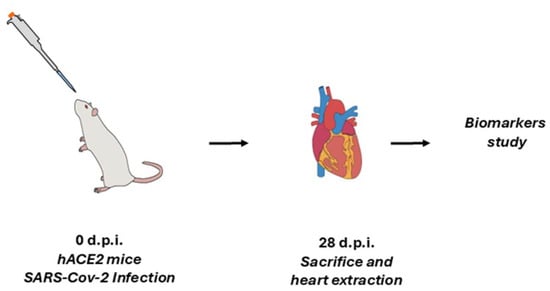-
 Identification and Characterization of MmuPV1 Causing Papillomatosis Outbreak in an Animal Research Facility
Identification and Characterization of MmuPV1 Causing Papillomatosis Outbreak in an Animal Research Facility -
 Potential for Core Fucose-Targeted Therapy Against HBV Infection of Human Normal Hepatocytes
Potential for Core Fucose-Targeted Therapy Against HBV Infection of Human Normal Hepatocytes -
 Broadly Sarbecovirus-Neutralizing Antibodies Induced by Ancestral SARS-CoV-2 Infection
Broadly Sarbecovirus-Neutralizing Antibodies Induced by Ancestral SARS-CoV-2 Infection -
 Dysregulation of microRNAs in the Brains of Mice Infected with Powassan Virus
Dysregulation of microRNAs in the Brains of Mice Infected with Powassan Virus -
 Immune Responses and Replication of Rescued Torque Teno Virus (TTSuV1) in Mice
Immune Responses and Replication of Rescued Torque Teno Virus (TTSuV1) in Mice
Journal Description
Viruses
Viruses
is a peer-reviewed, open access journal of virology, published monthly online by MDPI. The Spanish Society for Virology (SEV), Canadian Society for Virology (CSV), Italian Society for Virology (SIV-ISV), Australasian Virology Society (AVS), Brazilian Society for Virology (BSV) and others are affiliated with Viruses and their members receive a discount on the article processing charges.
- Open Access— free for readers, with article processing charges (APC) paid by authors or their institutions.
- High Visibility: indexed within Scopus, SCIE (Web of Science), PubMed, MEDLINE, PMC, Embase, PubAg, and other databases.
- Journal Rank: JCR - Q2 (Virology) / CiteScore - Q1 (Virology/Infectious Diseases)
- Rapid Publication: manuscripts are peer-reviewed and a first decision is provided to authors approximately 18.6 days after submission; acceptance to publication is undertaken in 2.5 days (median values for papers published in this journal in the first half of 2025).
- Recognition of Reviewers: reviewers who provide timely, thorough peer-review reports receive vouchers entitling them to a discount on the APC of their next publication in any MDPI journal, in appreciation of the work done.
- Companion journal: Zoonotic Diseases.
Impact Factor:
3.5 (2024);
5-Year Impact Factor:
3.7 (2024)
Latest Articles
Cardiac Tissue Damage in a Female Animal Post-COVID Model: Relevance of Chemokine-Mediated Inflammation
Viruses 2025, 17(12), 1629; https://doi.org/10.3390/v17121629 - 16 Dec 2025
Abstract
Post-COVID cardiac complications have emerged as a significant and persistent clinical concern, yet their underlying mechanisms remain poorly understood. Animal models can act as proxies to investigate the pathophysiology of the human, post-acute sequelae of SARS-CoV-2 infection (PASC). The aim of this experimental
[...] Read more.
Post-COVID cardiac complications have emerged as a significant and persistent clinical concern, yet their underlying mechanisms remain poorly understood. Animal models can act as proxies to investigate the pathophysiology of the human, post-acute sequelae of SARS-CoV-2 infection (PASC). The aim of this experimental study was to evaluate the expression of inflammatory biomarkers in cardiac tissue 28 days after SARS-CoV-2 infection in a female hACE2 mouse model, with a focus on chemokine-mediated immune activation. Twelve female C57BL/6 hACE2 mice were infected with the Omicron variant (BA.1.17 lineage) of SARS-CoV-2, and eleven non-infected mice served as controls. Cardiac tissue was analyzed via Western blot for markers of innate immune activation (TLR4, MyD88, NF-κB) and pro-inflammatory cytokines (IL-6, IL-18, IL-1β, TNF-α, CD11d). Cardiac tissue injury markers (iNOS, PAI-1 and Connexin43) were also analyzed. Compared to non-infected mice, cardiac tissue from infected mice showed significantly higher expression of IL-6 (p = 0.028), indicating an inflammatory state, and CD11d (p = 0.016), suggesting an inflammatory stage accompanied by sustained activation of chemokine-mediated inflammatory signaling. No significant differences in TLR4 (p = 0.340), MyD88 (p = 0.410), NF-κB p65 (p = 0.780), IL-18 (p = 0.548), IL-1β (p = 0.455), and TNF-α (p = 0.125) expressions were observed Similarly, no changes in cardiac damage markers (iNOS: p = 0.4684; PAI-1: p = 0.5345; Connexin 43: p = 0.2879) were found. The results of this experimental study would support the hypothesis of persistent low-grade inflammation as a contributor to post-COVID cardiac sequelae in females that is not accompanied by severe tissue damage, as also observed in clinical studies. This study also reinforces the need for studies evaluating the functional and structural evolution of the myocardium after an acute SARS-CoV-2 infection.
Full article
(This article belongs to the Section Coronaviruses)
►
Show Figures
Open AccessReview
A Review of Receptor Recognition Mechanisms in Coronaviruses
by
Jie Liu, Wenjing Luo, Jianming Li, Bingyi Cai, Zhiwei Lei, Shiyun Lin, Zhuohong Chen, Zhaoyang Yue, Xulin Chen, Yongkui Li, Zhen Luo, Qiwei Zhang and Xin Chen
Viruses 2025, 17(12), 1628; https://doi.org/10.3390/v17121628 - 16 Dec 2025
Abstract
Cellular receptor recognition exerts fundamental roles during coronavirus infection. Clarifying the regulatory mechanism of virus receptor helps to better understand viral infection, transmission and pathogenesis; predict potential host and how viral escape from immune system; prevent coronavirus infection or develop treatment therapy. Herein,
[...] Read more.
Cellular receptor recognition exerts fundamental roles during coronavirus infection. Clarifying the regulatory mechanism of virus receptor helps to better understand viral infection, transmission and pathogenesis; predict potential host and how viral escape from immune system; prevent coronavirus infection or develop treatment therapy. Herein, we summarize current understanding of host receptor recognition mechanisms in the different genera of coronavirus family. And we also review diverse methodologies of identification and clarification of virus receptors. The integration of structural biology, multi-omics, computational predictions, synthetic biology and artificially engineered viral receptors, provide a powerful framework for elucidating coronavirus‒receptor interactions. This also supports the development of broad-spectrum antiviral agents, smart biosensors, and intervention strategies against emerging coronaviruses.
Full article
(This article belongs to the Special Issue Coronaviruses Pathogenesis, Immunity, and Antivirals (2nd Edition))
Open AccessCommunication
Hollow Protein Fibers Templated Synthesis of Pt/Pd Nanostructures with Peroxidase-like Activity
by
Beizhe Huang, Mengting Fan, Yuhan Li, Ting Zhang and Jianting Zhang
Viruses 2025, 17(12), 1627; https://doi.org/10.3390/v17121627 - 16 Dec 2025
Abstract
Supramolecular proteins have emerged as promising templates for guiding metal ion mineralization into well-defined nanomaterials because of their structural versatility and chemical diversity. However, the precise control of metal ion nucleation on the different reactive sites of protein templates remains challenging. In this
[...] Read more.
Supramolecular proteins have emerged as promising templates for guiding metal ion mineralization into well-defined nanomaterials because of their structural versatility and chemical diversity. However, the precise control of metal ion nucleation on the different reactive sites of protein templates remains challenging. In this study, a genetically engineered hollow tobacco mosaic virus protein fiber (TMVF) with excellent structural stability was employed to achieve selective mineralization of noble metal nanostructures either on its external surface or within its internal channel. Moreover, the Pt/Pd bimetallic nanowire (NW) was also successfully prepared by co-depositing Pt and Pd on the TMVF. The bimetallic NWs demonstrated a peroxidase-like activity, which enabled their application for cholesterol detection by cooperating with cholesterol oxidase.
Full article
(This article belongs to the Special Issue Application of Genetically Engineered Plant Viruses)
►▼
Show Figures
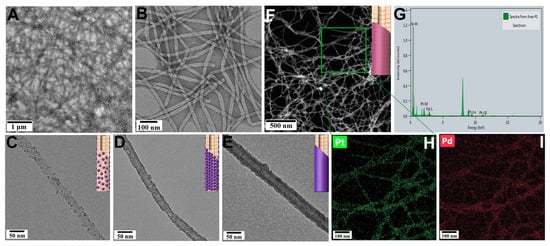
Figure 1
Open AccessArticle
Characteristics and Influencing Factors Among Newly Diagnosed HIV-1 Patients with Non-Marital, Non-Commercial Heterosexual Contact in Lishui, China (2020–2024)
by
Jianhua Mei, Jinkai Li, Xiaolei Chen, Liyang Qiu, Haifang Zhang, Jie Yu, Ling Ye, Deyong Zhang, Dongqing Cheng and Xiuying Chen
Viruses 2025, 17(12), 1626; https://doi.org/10.3390/v17121626 - 16 Dec 2025
Abstract
The increasing proportion of HIV-1 infections transmitted via non-marital non-commercial heterosexual contact (NMNCHC) in China necessitates a deeper understanding of its local characteristics. This study investigated the epidemiological, molecular network, and drug-resistant profiles among 400 newly diagnosed HIV-1 patients infected via non-marital heterosexual
[...] Read more.
The increasing proportion of HIV-1 infections transmitted via non-marital non-commercial heterosexual contact (NMNCHC) in China necessitates a deeper understanding of its local characteristics. This study investigated the epidemiological, molecular network, and drug-resistant profiles among 400 newly diagnosed HIV-1 patients infected via non-marital heterosexual contact (NMHC), specifically its non-commercial subtype, in Lishui from 2020–2024. HIV-1 pol gene sequences were analyzed for subtypes, drug resistance mutations, and transmission clusters using phylogenetic and network methods (genetic distance threshold: 0.9%). The overall prevalence of transmitted drug resistance (TDR) was 13.3%, an intermediate level exceeding the national average, driven predominantly by NNRTI resistance (6.3%). High-level resistance to NVP (3.0%) and EFV (2.75%) was observed. CRF08_BC (43.8%) was the dominant subtype. Multivariate analysis identified female gender and higher education as significant risk factors for NMNCHC acquisition. Molecular network analysis incorporated 55.3% of cases, revealing clusters predominantly composed of middle-aged and elderly males, with CRF08_BC and CRF01_AE showing higher NMNCHC transmission risk within networks. These findings underscore an evolving epidemic with significant TDR and highlight the urgent need for targeted interventions, including enhanced resistance surveillance and focused strategies for the concealed NMNCHC population, to curb local HIV-1 transmission.
Full article
(This article belongs to the Section Human Virology and Viral Diseases)
►▼
Show Figures
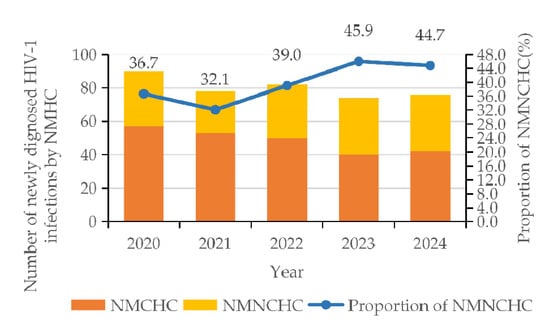
Figure 1
Open AccessArticle
TSWV Infection Differentially Reshapes the Symbiotic Microbiome of Two Frankliniella Thrips Species
by
Eeshita Mandal, Nuttapol Noirungsee, Terd Disayathanoowat and Eui-Joon Kil
Viruses 2025, 17(12), 1625; https://doi.org/10.3390/v17121625 - 16 Dec 2025
Abstract
Vectoring tomato spotted wilt virus (TSWV) by two well-known thrips species, Frankliniella occidentalis Pergande and F. intonsa Trybom (Thysanoptera: Thripidae), is facilitated in different ways. Symbiotic bacteria positively influence thrips fitness, but the interaction between these bacteria and tospovirus inside the thrips’ body
[...] Read more.
Vectoring tomato spotted wilt virus (TSWV) by two well-known thrips species, Frankliniella occidentalis Pergande and F. intonsa Trybom (Thysanoptera: Thripidae), is facilitated in different ways. Symbiotic bacteria positively influence thrips fitness, but the interaction between these bacteria and tospovirus inside the thrips’ body remains unknown. Metagenomic profiling of symbionts in nonviruliferous and viruliferous Frankliniella thrips was performed to elucidate the interactions between symbiotic bacteria and the virus. A total of 97 operational taxonomic units (OTUs) were identified by profiling the microbes, where Proteobacteria was the most abundant phylum, with a high richness in Serratia spp. F. occidentalis showed lower variation in bacterial diversity between nonviruliferous and viruliferous treatments than F. intonsa. RT-qPCR validation for Serratia and Escherichia revealed opposite abundance patterns between the two thrips species. In contrast, Enterobacteriaceae and Pantoea showed similar patterns with higher abundance in nonviruliferous conditions. Wolbachia was detected exclusively in F. intonsa, with a higher bacterial titer in the viruliferous sample. Our findings suggest that TSWV association may influence the abundance of different bacterial symbionts within the thrips’ body, potentially via induction of antimicrobial peptides in response to viral invasion, and to our knowledge this is the first report addressing this tripartite interaction. These findings improve our understanding of how virus–symbiont association contributes to thrips vector competence.
Full article
(This article belongs to the Special Issue Molecular Virus–Insect Interactions, 2nd Edition)
►▼
Show Figures
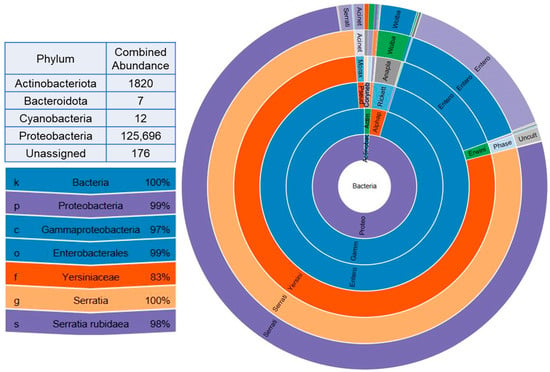
Figure 1
Open AccessReview
Does Myalgic Encephalomyelitis/Chronic Fatigue Syndrome (ME/CFS) Represent a Poly-Herpesvirus Post-Virus Infectious Disease?
by
Maria Eugenia Ariza, Irene Mena Palomo and Marshall V. Williams
Viruses 2025, 17(12), 1624; https://doi.org/10.3390/v17121624 - 16 Dec 2025
Abstract
Myalgic encephalomyelitis/chronic fatigue syndrome (ME/CFS) is a debilitating multisystem illness with unknown etiology. An estimated 17–24 million people representing approximately 1% of the population are afflicted worldwide. In over half of cases, ME/CFS onset is associated with acute “flu-like” symptoms, suggesting a role
[...] Read more.
Myalgic encephalomyelitis/chronic fatigue syndrome (ME/CFS) is a debilitating multisystem illness with unknown etiology. An estimated 17–24 million people representing approximately 1% of the population are afflicted worldwide. In over half of cases, ME/CFS onset is associated with acute “flu-like” symptoms, suggesting a role for viruses. However, no single virus has been identified as the only etiological agent. This may reflect the approach employed or more strongly the central dogma associated with herpesviruses replication, which states that a herpesvirus exists in two states, either lytic or latent. The purpose of this review is to address the role that abortive lytic replication may have in the pathogenesis of ME/CFS and other post-acute viral infections and also to raise awareness that these syndromes might be poly-herpesviruses mediated diseases.
Full article
(This article belongs to the Section Human Virology and Viral Diseases)
►▼
Show Figures
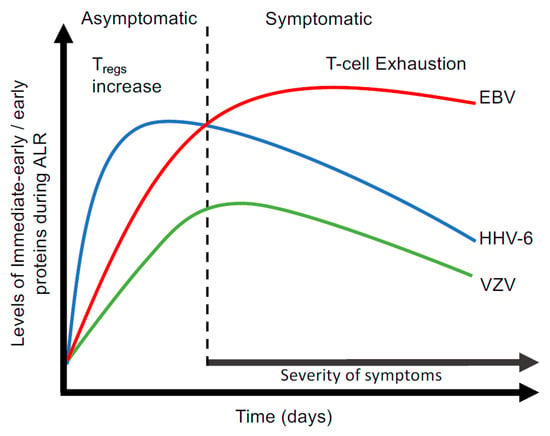
Figure 1
Open AccessArticle
Study of the Activity of the Staphylococcus aureus Phage vB_SaS_GE1 Against MRSA Clinical Isolates and Its Impact on the Formation of Dual-Species Biofilms with P. aeruginosa
by
Nino Grdzelishvili, Davit Lazviashvili, Aleksandra Kurowska, Krzysztof Jakub Pawlik, Łukasz Łaczmanski, Elene Kakabadze, Elene Zhuravliova, Nina Chanishvili and Nata Bakuradze
Viruses 2025, 17(12), 1623; https://doi.org/10.3390/v17121623 - 16 Dec 2025
Abstract
Bacteriophage therapy is regarded as a promising alternative for treating and preventing antibiotic-resistant bacterial infections. Methicillin-resistant Staphylococcus aureus (MRSA) is one of the most prevalent and difficult-to-treat pathogens. S. aureus also contributes to the formation of both single- and mixed-species biofilms. Treating biofilms
[...] Read more.
Bacteriophage therapy is regarded as a promising alternative for treating and preventing antibiotic-resistant bacterial infections. Methicillin-resistant Staphylococcus aureus (MRSA) is one of the most prevalent and difficult-to-treat pathogens. S. aureus also contributes to the formation of both single- and mixed-species biofilms. Treating biofilms remains a major challenge for antibiotic-based eradication of pathogens, as the biofilm matrix provides a protective barrier for bacteria. The selection of highly active phages targeting S. aureus is therefore crucial for medical applications, given the high prevalence and drug resistance of this pathogen. In this study, S. aureus phage vB_SaS_GE1 (GE1) was isolated and characterized as a potential therapeutic agent. The phage was isolated and propagated, and its host range was determined using standard methods. Whole-genome sequencing and annotation of the phage DNA were performed. A time–kill assay and evaluation of the anti-biofilm activity of the Staphylococcus phage, both alone and in combination with Pseudomonas phage GEC_PNG3 (PNG3) on mixed-species biofilms, were conducted. The results indicated that GE1 is a lytic phage that does not carry virulence-determining genes. The time–kill assay demonstrated sustained lytic activity of GE1 without the emergence of phage-resistant mutants in the tested MRSA strains. Although phage treatment increased biofilm matrix production compared to the control, the viable cell count within the biofilms was reduced. Overall, the characteristics assessed indicate that vB_SaS_GE1 is safe and exhibits strong antibacterial activity against MRSA strains.
Full article
(This article belongs to the Collection Phage Therapy)
►▼
Show Figures
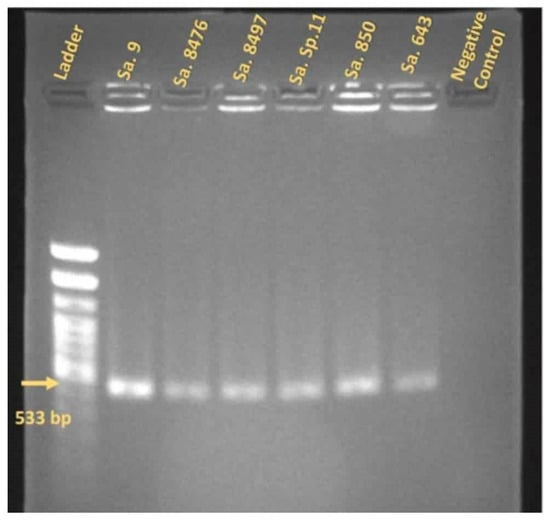
Figure 1
Open AccessArticle
Sociodemographic Associations and COVID-19 Symptoms Following One Year of Molecular Screening for SARS-CoV-2 Among Healthcare Workers
by
Viviane Campos Barbosa de Sena, Michelle Oliveira, Rejane Alencar Saldanha, Larissa Vicenza, Tais Hanae Kasai Brunswick, Bernardo Tura, Helena Cramer Veiga Rey, Adriana Bastos Carvalho, Antônio Carlos Campos de Carvalho, Djane Braz Duarte, Dayde Lane Mendonça da Silva and Daniel Arthur Barata Kasal
Viruses 2025, 17(12), 1622; https://doi.org/10.3390/v17121622 - 16 Dec 2025
Abstract
Background: During the COVID-19 pandemic, high rates of infection with SARS-CoV-2 were reported in healthcare workers (HCWs), among whom asymptomatic individuals had high potential to spread the virus while assisting high-risk patients. This study conducted routine SARS-CoV-2 screening among the staff of a
[...] Read more.
Background: During the COVID-19 pandemic, high rates of infection with SARS-CoV-2 were reported in healthcare workers (HCWs), among whom asymptomatic individuals had high potential to spread the virus while assisting high-risk patients. This study conducted routine SARS-CoV-2 screening among the staff of a specialized cardiology hospital in Brazil during 2022 and 2023, while also evaluating variables associated with infection and the occurrence of symptoms. Methods: A prospective cohort study of 94 HCWs with biweekly RT-PCR screening was performed, employing RT-PCR from nasal swabs. Results: Participants aged 50.9 ± 10.2 years and were predominantly female (85.1%) and non-white (56.4%). The follow-up period was 576.4 ± 185.9 days, and most participants worked in the intensive care unit/emergency department (34%). Although the HCWs with the highest COVID-19 rates before inclusion were technicians/graduates (67.3%) and non-white individuals (57.7%), these groups presented lower infection rates at follow-up (p < 0.001, CI 95% 2.924–27.93; and p = 0.02, CI 95% 0.129–0.859, respectively). The number of asymptomatic cases increased during the study (p = 0.001), and simultaneous infection upsurges occurred in different hospital departments. Interpretation: These data highlight the association between educational level and the risk of SARS-CoV-2 infection in HCWs. The synchronicity of cases in different hospital departments offers insights about the nosocomial spread of SARS-CoV-2. The increase in the number of asymptomatic infections with repeated infections suggests that regular molecular screening may contribute to increasing the safety of both patients and HCWs in a pandemic context.
Full article
(This article belongs to the Special Issue Molecular Epidemiology of SARS-CoV-2, 4th Edition)
►▼
Show Figures
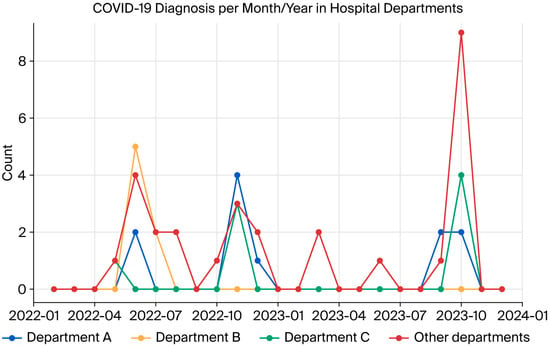
Figure 1
Open AccessEditorial
Pestivirus 2024: Special Issue Editorial
by
Benjamin J. Lamp and Christiane M. Riedel
Viruses 2025, 17(12), 1621; https://doi.org/10.3390/v17121621 - 16 Dec 2025
Abstract
Pestiviruses are well known in the veterinary field and include some of the most economically significant pathogens of ungulates, such as classical swine fever virus (CSFV) and bovine viral diarrhea virus (BVDV) [...]
Full article
(This article belongs to the Special Issue Pestivirus 2024)
Open AccessBrief Report
Co-Circulation of Tick-Borne Bandaviruses and Orthonairoviruses Across Humans, Livestock, and Rats in Pakistan: Serologic Evidence and Public Health Implications
by
Muhammad Ammar, Shengyao Chen, Muhammad Saqib, Jingyuan Zhang, Awais-Ur-Rahman Sial, Asad Zia, Yaohui Fang, Muhammad Khalid Mansoor, Abulimiti Moming, Asim Shahzad, Rehman Hafeez, Aneela Javed, Ali Hassan, Ben Hu, Ali Zohaib, Shu Shen and Fei Deng
Viruses 2025, 17(12), 1620; https://doi.org/10.3390/v17121620 - 15 Dec 2025
Abstract
Tick-borne viruses (TBVs) pose significant public health and economic threats. Pakistan has endemic Crimean-Congo hemorrhagic fever virus (CCHFV), but evidence suggests broader TBV circulation. This study assessed the seroprevalence of thirteen TBVs (seven are members of the genus Orthonairovirus and six are members
[...] Read more.
Tick-borne viruses (TBVs) pose significant public health and economic threats. Pakistan has endemic Crimean-Congo hemorrhagic fever virus (CCHFV), but evidence suggests broader TBV circulation. This study assessed the seroprevalence of thirteen TBVs (seven are members of the genus Orthonairovirus and six are members of the genus Bandavirus) in humans, livestock, and rats in Punjab, Pakistan. Serum samples (n = 794: 321 livestock, 253 human, and 220 rat) were collected from the Narowal, Lahore, and Faisalabad districts. Antibodies to viral NPs were detected using the luciferase immunoprecipitation system (LIPS). The overall seroprevalence was 19.14% (152/794); it was highest in livestock (27.10%), then humans (20.55%), and then rats (5.91%). The highest seroprevalence rates were 3.12% for CCHFV in livestock, 3.56% for Yezo virus (YEZV) in humans, and 0.91% for Tamdy virus (TAMV) and Tacheng tick virus 1 (TcTV-1) in rats. Neutralizing antibodies were detected against CCHFV (1 cattle, 4 humans), Bhanja virus (BHAV) (3 livestock, 1 rat), TAMV (1 cattle), Guertu virus (GTV) (1 cattle), and Dabie bandavirus (2 cattle). Sixteen samples showed antibodies to both orthonairoviruses and bandaviruses, indicating co-exposure. Further analysis showed that seropositivity was not randomly distributed. Livestock kept in commercial farming systems and people working mainly outdoors had distinctly higher exposure to TBVs than subsistence livestock and indoor workers. The results supported the circulation of TBVs among hosts within the close socio-economic/ecological integration area of Pakistan. These findings confirm the circulation of CCHFV, SFTSV, GTV, and TAMV; provide the first serologic evidence of BHAV in Pakistan; and underscore the need for further investigation into the potential circulation of additional TBVs. All results demonstrated that multiple TBVs have been circulating among humans, livestock, and rodents in Pakistan.
Full article
(This article belongs to the Special Issue Tick-Borne Viruses 2026)
►▼
Show Figures

Figure 1
Open AccessArticle
Sequential Dengue Virus Infection in Marmosets: Histopathological and Immune Responses in the Liver
by
Daniele Freitas Henriques, Livia M. N. Casseb, Milene S. Ferreira, Larissa S. Freitas, Hellen T. Fuzii, Carla Pagliari, Luciane Kanashiro, Paulo H. G. Castro, Gilmara A. Siva, Orlando Pereira Amador Neto, Valter M. Campos, Beatriz C. Belvis, Flavia B. dos Santos, Lilian R. M. de Sá and Pedro Fernando da Costa Vasconcelos
Viruses 2025, 17(12), 1619; https://doi.org/10.3390/v17121619 - 15 Dec 2025
Abstract
This study evaluated hepatic pathological and phenotypic alterations, along with the inflammatory response, following sequential dengue virus (DENV) infection in Callithrix penicillata, a relevant model for human endemic scenarios. Twenty-six animals were initially infected subcutaneously with DENV-3. Thirteen were euthanized between 1 and
[...] Read more.
This study evaluated hepatic pathological and phenotypic alterations, along with the inflammatory response, following sequential dengue virus (DENV) infection in Callithrix penicillata, a relevant model for human endemic scenarios. Twenty-six animals were initially infected subcutaneously with DENV-3. Thirteen were euthanized between 1 and 7 days post-infection (dpi) to assess the acute phase, and up to 60 dpi for the convalescent phase. The remaining animals received a secondary DENV-2 infection two months later. Liver samples underwent histopathological and immunohistochemical analysis. Viral antigens were identified in hepatocytes, Kupffer cells, and Councilman bodies. Observed liver changes included apoptosis, lytic necrosis, midzonal inflammation, Kupffer cell hyperplasia and hypertrophy, sinusoidal dilation, and hemosiderin deposition. Both primary and secondary infections increased activated macrophages, NK cells, S-100 protein, and B lymphocytes. Primary infection was associated with elevated CD4+ T cells, IFN-γ, TGF-β, IL-10, and Fas expression, whereas secondary infection induced higher IFN-γ, TNF-α, IL-8, Fas, and VCAM levels. These findings mirror hepatic alterations in severe human dengue cases and underscore the role of direct viral effects and immune dysregulation in liver injury. The results support C. penicillata as a suitable non-human primate model for studying DENV pathogenesis.
Full article
(This article belongs to the Section Human Virology and Viral Diseases)
►▼
Show Figures

Figure 1
Open AccessArticle
An Attenuated Recombinant Newcastle Disease Virus of Genotype VII Generated by Reverse Genetics
by
Hongze Pang, Yidan Bo, Jiawei Chen, Yongzhi Xue, Baishi Lei, Kuan Zhao, Yu Huang, Wenming Jiang, Wuchao Zhang and Wanzhe Yuan
Viruses 2025, 17(12), 1618; https://doi.org/10.3390/v17121618 - 15 Dec 2025
Abstract
Genotype VII Newcastle disease virus (NDV) has been confirmed as the predominant epidemic strain in China. Traditional vaccine strains fail to provide complete immune protection when challenged with an epidemic strain. NDV vaccines with phylogenetic relationships closer to those of the endemic viruses
[...] Read more.
Genotype VII Newcastle disease virus (NDV) has been confirmed as the predominant epidemic strain in China. Traditional vaccine strains fail to provide complete immune protection when challenged with an epidemic strain. NDV vaccines with phylogenetic relationships closer to those of the endemic viruses demonstrate improved protective efficacy in reducing viral shedding and transmission. This research seeks to develop attenuated vaccine strains that are specifically aligned with NDV genotype VII. A reverse genetics system for the genotype VII NDV HB strain was developed, successfully rescuing the attenuated recombinant virus aHB by substituting the fusion protein (F) cleavage site motif “112R-R-Q-K-R↓F117” with “112G-R-Q-G-R↓L117.” Recombinant aHB virus attenuation was verified by assessing the mean death time (MDT) and intracerebral pathogenicity index (ICPI). The attenuated aHB strain demonstrated greater proliferation titers than did the virulent HB and rHB strains both in vivo and in vitro. Furthermore, the genome exhibited significant genetic stability even after 10 passages in chicken embryos. When challenged with the HB strain of NDV genotype VII, the aHB-inactivated vaccine provided 100% protection to chickens and effectively prevented viral shedding. These findings indicate that recombinant aHB may serve as an effective vaccine candidate.
Full article
(This article belongs to the Section Animal Viruses)
►▼
Show Figures
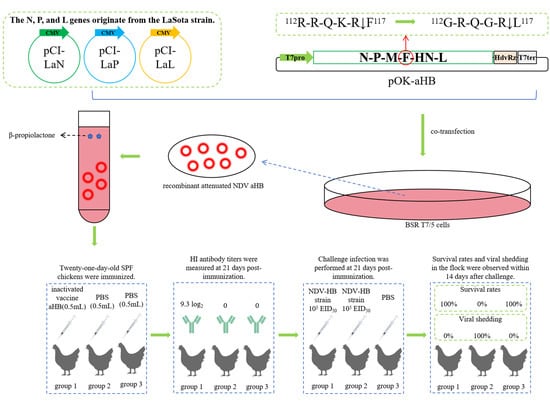
Graphical abstract
Open AccessArticle
Differences in the Phenotype of Bacterial and Viral Sepsis—A Prospective, Multicenter, Observational Study
by
Fabian Perschinka, Georg Franz Lehner, Timo Mayerhöfer, Andrea Köhler, Walter Hasibeder, Christoph Krismer, Julia Killian, Dietmar Fries, Johannes Bösch, Norbert Perschinka, Peter Hohenauer, Nadine Perschinka, Anna Lisa Hackl and Michael Joannidis
Viruses 2025, 17(12), 1617; https://doi.org/10.3390/v17121617 - 14 Dec 2025
Abstract
Sepsis is defined as a dysregulated host response to an infection, leading to life-threatening organ dysfunction. While sepsis is most commonly the result of a bacterial infection, it may also be caused by viral pathogens. The aim of this study was to describe
[...] Read more.
Sepsis is defined as a dysregulated host response to an infection, leading to life-threatening organ dysfunction. While sepsis is most commonly the result of a bacterial infection, it may also be caused by viral pathogens. The aim of this study was to describe differences in organ dysfunction patterns and inflammatory markers between bacterial and viral sepsis. In this prospective multicenter cohort study, adults meeting SEPSIS-3 criteria were recruited from four Austrian ICUs between 1 August 2021 and 1 April 2024, excluding those who were immunocompromised within the preceding 12 months. Ninety patients were enrolled, of whom 57 had bacterial and 33 viral sepsis. Inflammatory markers, including IL-6 and PCT, were higher at ICU admission in bacterial sepsis. Adjusted linear regression confirmed bacterial etiology as the only significant predictor of higher 48 h peak IL-6 and PCT values. Patients with viral sepsis typically fulfilled SEPSIS-3 criteria through respiratory and cardiovascular SOFA components, while other organ dysfunctions were less frequent. Significant differences in the phenotype of bacterial and viral sepsis were observed, characterized by distinct inflammatory profiles and differing patterns of organ dysfunction. These findings may support the improved differentiation of bacterial and viral etiologies in sepsis.
Full article
(This article belongs to the Special Issue Cross-Pathogen Insights into Infectious Diseases: From Biomarkers to Burden and Therapeutic Strategies of Viral Pathogens)
►▼
Show Figures
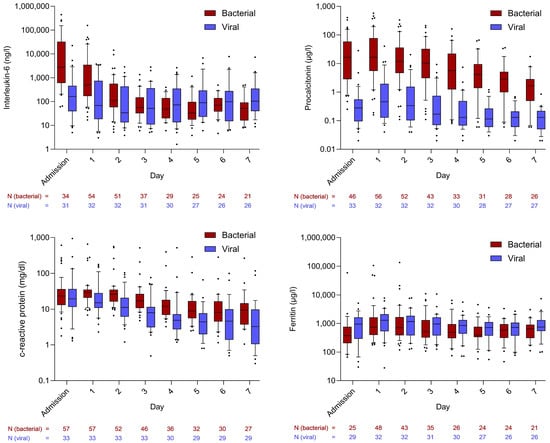
Figure 1
Open AccessEditorial
Special Issue: “Innate Immunity to Virus Infection, 2nd Edition”
by
Xinyu Zhang and Caijun Sun
Viruses 2025, 17(12), 1616; https://doi.org/10.3390/v17121616 - 14 Dec 2025
Abstract
The frequent emergence of highly pathogenic viruses globally has persistently threatened global health [...]
Full article
(This article belongs to the Special Issue Innate Immunity to Virus Infection 2nd Edition)
Open AccessReview
CAR-T Cell Therapy for HIV Cure: Current Challenges, Advances and Future Directions
by
Monica-Daniela Padurariu-Covit, Costinela Georgescu, Mihaela Andreescu, Iulia Chiscop, Catalin Plesea-Condratovici and Manuela Arbune
Viruses 2025, 17(12), 1615; https://doi.org/10.3390/v17121615 - 14 Dec 2025
Abstract
Antiretroviral therapy (ART) effectively suppresses HIV replication but fails to eradicate latent reservoirs, leading to viral rebound after interruption. Chimeric antigen receptor (CAR) T-cell therapy offers a potential strategy to achieve durable remission. A systematic PubMed search (July 2020–June 2025) identified 253 studies
[...] Read more.
Antiretroviral therapy (ART) effectively suppresses HIV replication but fails to eradicate latent reservoirs, leading to viral rebound after interruption. Chimeric antigen receptor (CAR) T-cell therapy offers a potential strategy to achieve durable remission. A systematic PubMed search (July 2020–June 2025) identified 253 studies on CAR-T therapy in HIV; 74 met inclusion criteria and were qualitatively analyzed. Preclinical data showed that CAR-T cells can recognize and eliminate infected cells, reach viral reservoirs, and persist long term, particularly when derived from hematopoietic stem cells. Dual-target and combination approaches with checkpoint inhibitors or latency-reversing agents enhanced antiviral efficacy. Early clinical studies confirmed safety and modest reservoir reduction. CAR-T cell therapy represents a promising step toward a functional HIV cure. Further optimization of design, integration with gene-editing technologies, and standardized clinical evaluation are required to confirm durable efficacy and safety.
Full article
(This article belongs to the Special Issue HIV Reservoirs, Latency, and the Factors Responsible)
►▼
Show Figures
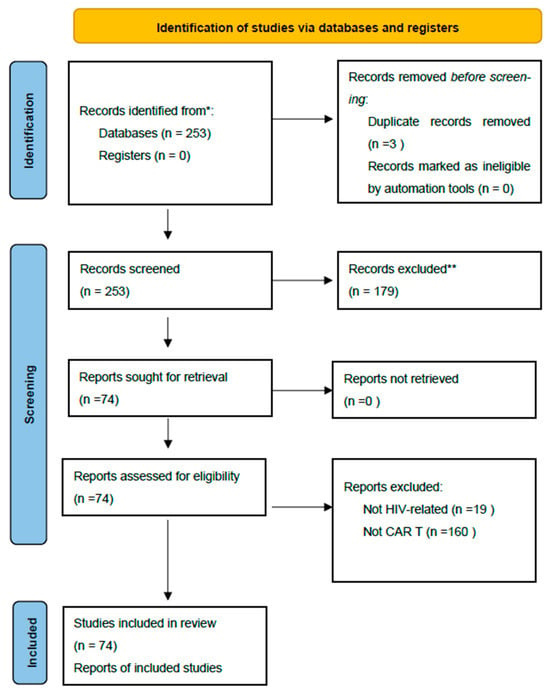
Figure 1
Open AccessArticle
Generating STEC-Specific Ackermannviridae Bacteriophages Through Tailspike Protein Chimerization
by
Jose Gil, John Paulson, Henriett Zahn, Matthew Brown, Minh M. Nguyen and Stephen Erickson
Viruses 2025, 17(12), 1614; https://doi.org/10.3390/v17121614 - 14 Dec 2025
Abstract
Shiga toxin-producing Escherichia coli (STEC) pose a significant threat to public health and effective methods of detection are needed. The use of naturally occurring bacteriophages (phages) to detect E. coli has been well documented. However, detecting multiple serotypes at the same time often
[...] Read more.
Shiga toxin-producing Escherichia coli (STEC) pose a significant threat to public health and effective methods of detection are needed. The use of naturally occurring bacteriophages (phages) to detect E. coli has been well documented. However, detecting multiple serotypes at the same time often required multiple phages specific to individual serotypes. To limit the burden of complex cocktails, this study aimed to engineer phages with an expanded host range that allows each phage to contribute to detection across multiple STEC serogroups. Kutterviruses, in the Ackermannviridae family, contain four tailspike proteins (TSPs), each of which confers tropism to a different bacterial strain. The modular nature of TSPs allows for mixing receptor-binding domains from diverse phage types. The host range of the Kuttervirus CBA120 was modified by replacing its native tailspike proteins (TSPs) with chimeric versions incorporating receptor-binding domains from related and unrelated phages. A structure-guided approach was utilized to overcome minimal sequence similarity between donor and recipient phages and achieve novel functional TSP chimeras. Two engineered phage variants were created that collectively detect five STEC serogroups: O26, O45, O103, O111, and O157. Spotting and luciferase assays confirmed that the replacement TSPs were functional and the phages had acquired new host ranges. This study demonstrates the feasibility of engineering Ackermannviridae phages with customized host ranges for detecting multiple STEC strains. This approach has potential applications in developing improved phage-based bacterial detection, therapy, and biocontrol.
Full article
(This article belongs to the Special Issue Biotechnological Applications of Phage and Phage-Derived Proteins 2025)
►▼
Show Figures
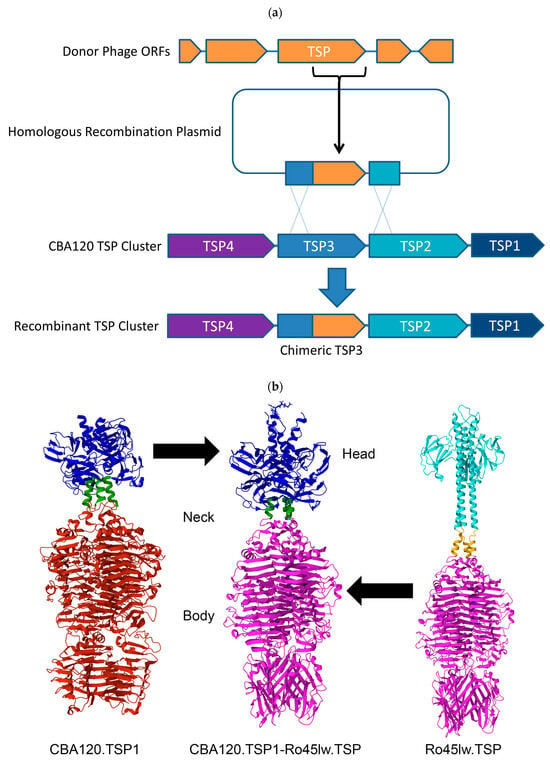
Figure 1
Open AccessArticle
Repurposing FDA-Approved Drugs as Hendra Virus RNA-Dependent RNA Polymerase Inhibitors: A Comprehensive Computational Drug Discovery Approach
by
Anjana C. Lalu, Varun Thachan Kundil, Bristow Ben Joseph, Radul R. Dev, Amritha Thaikkad, Suhail Subair, Rajesh Raju and Abhithaj Jayanandan
Viruses 2025, 17(12), 1613; https://doi.org/10.3390/v17121613 - 13 Dec 2025
Abstract
Hendra virus (HeV) is a highly pathogenic zoonotic paramyxovirus that poses a serious threat to human and equine health, yet no approved antivirals or vaccines currently exist. RNA-dependent RNA polymerase (RdRp) of Hendra virus represents a critical and attractive target for antiviral drug
[...] Read more.
Hendra virus (HeV) is a highly pathogenic zoonotic paramyxovirus that poses a serious threat to human and equine health, yet no approved antivirals or vaccines currently exist. RNA-dependent RNA polymerase (RdRp) of Hendra virus represents a critical and attractive target for antiviral drug development, given its essential role in both viral genome replication and mRNA transcription. Due to the lack of a human homolog, it is more druggable and less likely to cause host toxicity. Its sequence conservation among related paramyxoviruses further highlights its potential for the development of broad-spectrum inhibitors. This study offers the first comprehensive computational analysis of the Hendra virus RdRp, potentially promising FDA-approved drugs as possible inhibitors. A homology model of RdRp was generated in the absence of experimental three-dimensional (3D) structure, followed by virtual screening and molecular dynamics (MD) simulations to evaluate the drug binding and stability. Based on the highest energy, four FDA-approved drugs selected were menadiol diphosphate (−49.88 kcal/mol), masoprocol (−39.69 kcal/mol), pamidronic acid (−34.29 kcal/mol), and dinoprostone (−46.90 kcal/mol). Furthermore, these compounds exhibited significant interactions with the catalytic GDNE motif. With strong conformational stability and pharmacokinetic profile, masoprocol and menadiol diphosphate showed the most stable and energetically favorable interactions within the RdRp active site. These findings suggest their potential as repurposed therapeutic candidates against Hendra virus infection and they provide a structural basis for the development of broad-spectrum paramyxovirus inhibitors, justifying additional experimental confirmation.
Full article
(This article belongs to the Special Issue Zoonotic and Vector-Borne Viral Diseases: 2nd Edition)
►▼
Show Figures
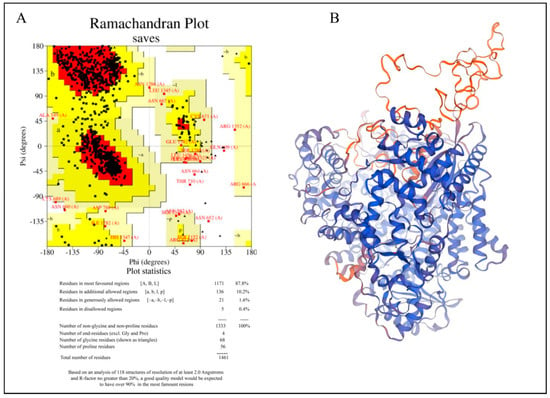
Figure 1
Open AccessOpinion
COVID-19 Double Annual Epidemic Peaks in Summer and in Winter from 2022, Irrespective of the Rate of Mask Wearing and Vaccination
by
Shinako Inaida, Richard E. Paul and Minsoo Kim
Viruses 2025, 17(12), 1612; https://doi.org/10.3390/v17121612 - 13 Dec 2025
Abstract
Although vaccination for COVID-19 and mask wearing were two of the main preventive measures against infection, their impact is unclear. In the present study, by using national surveillance data in Japan, we compared the incidence rate and weekly case increase ratios of COVID-19
[...] Read more.
Although vaccination for COVID-19 and mask wearing were two of the main preventive measures against infection, their impact is unclear. In the present study, by using national surveillance data in Japan, we compared the incidence rate and weekly case increase ratios of COVID-19 with the domestic stocks of masks and vaccination coverage. The trajectory of epidemic growth increased rapidly in the summer of 2021, concomitant with the launch of the mass national vaccination program. The most rapid spread of the epidemic was found in 2022, approximately 6 months after the national mass vaccination started, with the emergence of the Omicron variant. From 2022, two annual epidemic peaks occurred with seasonal changes. Whilst the winter peak follows the expected seasonal trend in respiratory infections, the summer peak may reflect a combination of short-term herd immunity and behavioral patterns. Nevertheless, these epidemic peaks continued irrespective of vaccine coverage and mask use. Further analysis into the duration of protective efficacy of the vaccines and mask use is required.
Full article
(This article belongs to the Special Issue SARS-CoV-2, COVID-19 Pathologies, Long COVID, and Anti-COVID Vaccines)
Open AccessArticle
Molecular Testing in Organ Biopsies and Perfusion Fluid Samples from Severe Acute Respiratory Syndrome Coronavirus 2 Positive Donors
by
Evangelia Petrisli, Liliana Gabrielli, Carlo De Cillia, Andrea Liberatore, Giulia Piccirilli, Simona Venturoli, Alice Balboni, Eva Caterina Borgatti, Alessia Cantiani, Lamberto Manzoli, Nicola Alvaro and Tiziana Lazzarotto
Viruses 2025, 17(12), 1611; https://doi.org/10.3390/v17121611 - 13 Dec 2025
Abstract
At the beginning of the COVID-19 pandemic, SARS-CoV-2-positive donors were not considered eligible for organ donation. The Italian National Transplant Centre has gradually introduced measures to prevent donor-to-recipient transmission of SARS-CoV-2 infection through organ transplantation. The current national screening protocol for deceased SARS-CoV-2-positive
[...] Read more.
At the beginning of the COVID-19 pandemic, SARS-CoV-2-positive donors were not considered eligible for organ donation. The Italian National Transplant Centre has gradually introduced measures to prevent donor-to-recipient transmission of SARS-CoV-2 infection through organ transplantation. The current national screening protocol for deceased SARS-CoV-2-positive donors recommends molecular testing of donor lower respiratory tract (LRT) samples, graft biopsies and organ perfusion fluids. The aim of the study is to describe the 3-year experience of protocol application in a northern region of Italy. From 1 January 2022 to 31 January 2025, a total of 132 samples were analyzed (29 liver biopsies, 35 kidney biopsies, 68 perfusion fluids) from 40 organ donors with an active or resolved SARS-CoV-2 infection. SARS-CoV-2 PCR on LRT samples was positive in 26/40 (65%) donors, negative in 11/40 (27.5%) cases and in the remaining 3 (7.5%) the PCR result was unknown. Overall, 65 organs were transplanted into 60 recipients. All processed graft biopsies and organ perfusion fluid samples tested negative for SARS-CoV-2 RNA. Our data suggest that the utilization of non-lung donors with resolved or active SARS-CoV-2 infections who died of other causes appears justified and safe.
Full article
(This article belongs to the Section Coronaviruses)
►▼
Show Figures
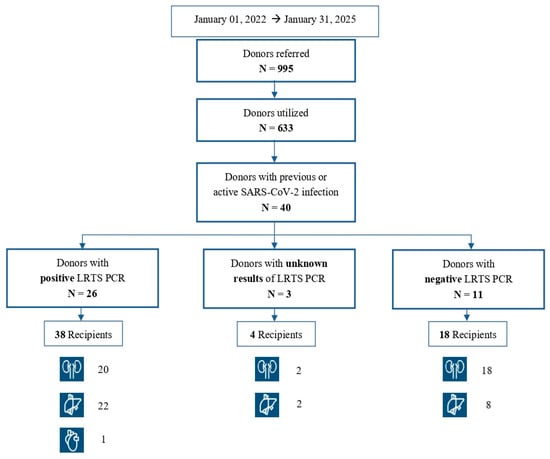
Figure 1
Open AccessArticle
Clinical and Immunological Recovery Trajectories in Severe COVID-19 Survivors: A 12-Month Prospective Follow-Up Study
by
Edita Strumiliene, Laura Malinauskiene, Jurgita Urboniene, Laimutė Jurgauskienė, Birutė Zablockienė and Ligita Jancoriene
Viruses 2025, 17(12), 1610; https://doi.org/10.3390/v17121610 - 12 Dec 2025
Abstract
Background: The link between clinical recovery and immune restoration after severe COVID-19 remains poorly defined. Although most survivors experience symptomatic improvement, persistent symptoms have been hypothesized to reflect ongoing immune dysregulation. Methods: This prospective cohort study followed 93 unvaccinated adults with RT-PCR-confirmed moderate-to-critical
[...] Read more.
Background: The link between clinical recovery and immune restoration after severe COVID-19 remains poorly defined. Although most survivors experience symptomatic improvement, persistent symptoms have been hypothesized to reflect ongoing immune dysregulation. Methods: This prospective cohort study followed 93 unvaccinated adults with RT-PCR-confirmed moderate-to-critical COVID-19 at 3, 6, and 12 months post-discharge. Clinical assessments used structured interviews to evaluate the persistent symptoms. Peripheral blood analyses were used to measure lymphocyte subsets, immunoglobulins, and complement components. Results: Clinical recovery was substantial; fatigue prevalence declined from 70.9% to 24.7% and dyspnea prevalence from 81.7% to 25.8% by 12 months (p < 0.001 for both). However, immune recovery exhibited divergent patterns. Activated T cells (CD3+HLA-DR+) decreased significantly (from 20% to 13%; p < 0.001), complement C3c levels paradoxically increased from 1.23 to 1.35 g/L (p < 0.001), and serum IgA increased by 32% (p = 0.003). NK cells remained stable overall but were persistently reduced in a subset (~25%) of patients, particularly among those with fatigue and dyspnea. Critical illness was associated with slower T-cell resolution, prolonged IgM elevation, and increased complement activity. Conclusions: One year after hospitalization, most patients achieved substantial clinical improvement, but immune reconstitution lagged behind. These findings highlight the dissociation between clinical and immunological recovery and suggest that persistent immune dysregulation may be associated with long COVID manifestations. Incorporating immune monitoring into post-COVID care may help identify patients at risk of prolonged sequelae and guide targeted therapeutic strategies.
Full article
(This article belongs to the Special Issue Coronavirus Pathogenesis and Virus-Host Interaction)
►▼
Show Figures
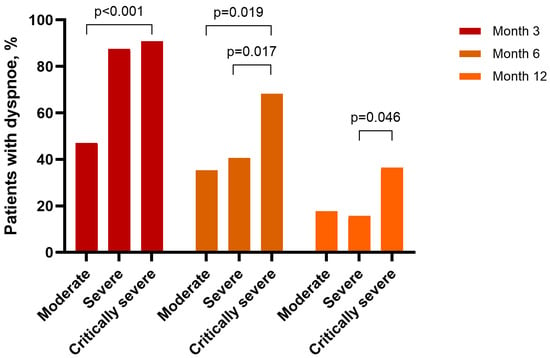
Figure 1

Journal Menu
► ▼ Journal Menu-
- Viruses Home
- Aims & Scope
- Editorial Board
- Reviewer Board
- Topical Advisory Panel
- Instructions for Authors
- Special Issues
- Topics
- Sections & Collections
- Article Processing Charge
- Indexing & Archiving
- Editor’s Choice Articles
- Most Cited & Viewed
- Journal Statistics
- Journal History
- Journal Awards
- Society Collaborations
- Conferences
- Editorial Office
Journal Browser
► ▼ Journal BrowserHighly Accessed Articles
Latest Books
E-Mail Alert
News
Topics

Conferences
Special Issues
Special Issue in
Viruses
Diversity and Coinfections of Plant or Fungal Viruses, 3rd Edition
Guest Editors: Islam Hamim, Ken Komatsu, Hiromitsu MoriyamaDeadline: 20 December 2025
Special Issue in
Viruses
Virology in Italy 2025—9th National Congress of the Italian Society for Virology
Guest Editors: Enzo Tramontano, Arnaldo Caruso, Massimiliano Galdiero, Luisa Rubino, Gabriele VaccariDeadline: 20 December 2025
Special Issue in
Viruses
RSV Epidemiological Surveillance: 2nd Edition
Guest Editors: Emanuele Castagno, Irene RaffaldiDeadline: 30 December 2025
Special Issue in
Viruses
Understanding the Oncogenesis of Human Herpesviruses through Their Critical Comparisons
Guest Editors: Ya-Fang Chiu, Bill SugdenDeadline: 30 December 2025
Topical Collections
Topical Collection in
Viruses
Poxviruses
Collection Editors: Giliane de Souza Trindade, Galileu Barbosa Costa, Flavio Guimaraes da Fonseca
Topical Collection in
Viruses
Efficacy and Safety of Antiviral Therapy
Collection Editors: Giordano Madeddu, Andrea De Vito, Agnese Colpani
Topical Collection in
Viruses
Phage Therapy
Collection Editors: Nina Chanishvili, Jean-Paul Pirnay, Mikael Skurnik



